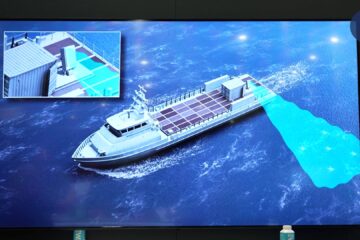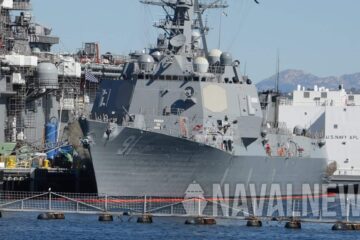Alongside the Surface Electronic Warfare Improvement Program (SEWIP) Block 3 – which introduces an electronic attack (EA) function into the broader SEWIP architecture – the navy is also procuring the helicopter-borne AN/ALQ-248 Advanced Offboard Electronic Warfare (AOEW) mission payload. Development of a next generation expendable long endurance autonomous offboard decoy is at an earlier stage.
SEWIP Block 3 adds a Northrop Grumman-developed EA suite to the existing Lockheed Martin AN/SLQ-32(V)6 suite to create the AN/SLQ-32(V)7 variant. More specifically, Block 3 implements active electronically scanned arrays based on Gallium Nitride transmit/receive modules, and capitalizes on technology previously matured through the Office of Naval Research’s Integrated Topside science and technology program. As well as jamming targeting radars and missile seekers, the Block 3 increment will also host a government-furnished Soft Kill Coordination System (SKCS) that will provide direction and scheduling for both onboard and offboard soft-kill effectors.
USS Pinckney (DDG 91) is the first DDG-51 Flight IIA destroyer to receive the AN/SLQ-32(V)7 fit – embodied as ship alteration 79521K – as part of the wider DDG MOD 2.0 upgrade program. The ship has been running post-availability shakedown trials from General Dynamics’ NASSCO shipyard in San Diego since November 2023, with a next underway scheduled for early March.
Next in line for SEWIP Block 3 are USS Chung-Hoon (DDG 93) and USS James E. Williams (DDG 95). General Dynamics NASSCO received a US$53 million contract modification from the navy in late January to implement the 79521K ship alteration package on the two ships.
DDG 51 Flight IIA ships are receiving the AN/SLQ-32(V)7 Hemisphere configuration, with sponson-mounted ‘shoulder pad’ installations on the port and starboard sides of the main deckhouse block. A modified Quadrant configuration, using distributed and repackaged hardware building blocks, is slated for the Nimitz-class and Ford-class nuclear-powered aircraft carriers and Wasp-class amphibious assault ships.
While Northrop Grumman is delivering SEWIP Block 3, Lockheed Martin’s Rotary and Mission Systems business is in parallel progressing the development and low-rate initial production (LRIP) of the AN/ALQ-248 AOEW system. Integrated into the MH-60S/R helicopter, the AOEW payload is a self-contained pod containing both high sensitivity receiver and EA subsystems.

The AN/ALQ-248 AOEW payload can operate independently, or coordinated with the shipborne SEWIP system. In the latter case, the AN/SLQ-32 system will detect incoming anti-ship missile threats, then cue and control the AOEW pod (via Link 16) using its SKCS function; AN/SLQ-248 EA effects will be coordinated by SLQ-32/SKCS in conjunction with other soft-kill radio frequency (RF) countermeasures during the engagement.
Lockheed Martin earlier this year wrapped up FQT-1B testing for AN/ALQ-248 using engineering development model hardware and software. The company expects to commence AOEW LRIP deliveries during 2024: the US Navy plans to begin initial operational test and evaluation in Fiscal Year 2026.

The US Navy is also sponsoring early development of a new Long Endurance Electronic Decoy (LEED) which will marry a modular RF payload with an autonomous flight vehicle. The latter will include a communications link for command and control updates in order to reposition and realign to the threat. The navy says that LEED will “provide the fleet with enhanced EW coordination and capability, including the ability to stretch engagement timelines and counter heterogeneous missile attacks”. Lockheed Martin Missiles and Fire Control has been selected as prime contractor to lead the LEED development effort: the program will leverage technologies being developed and matured by the Office of Naval Research under its parallel Long Endurance Airborne Platform project.






